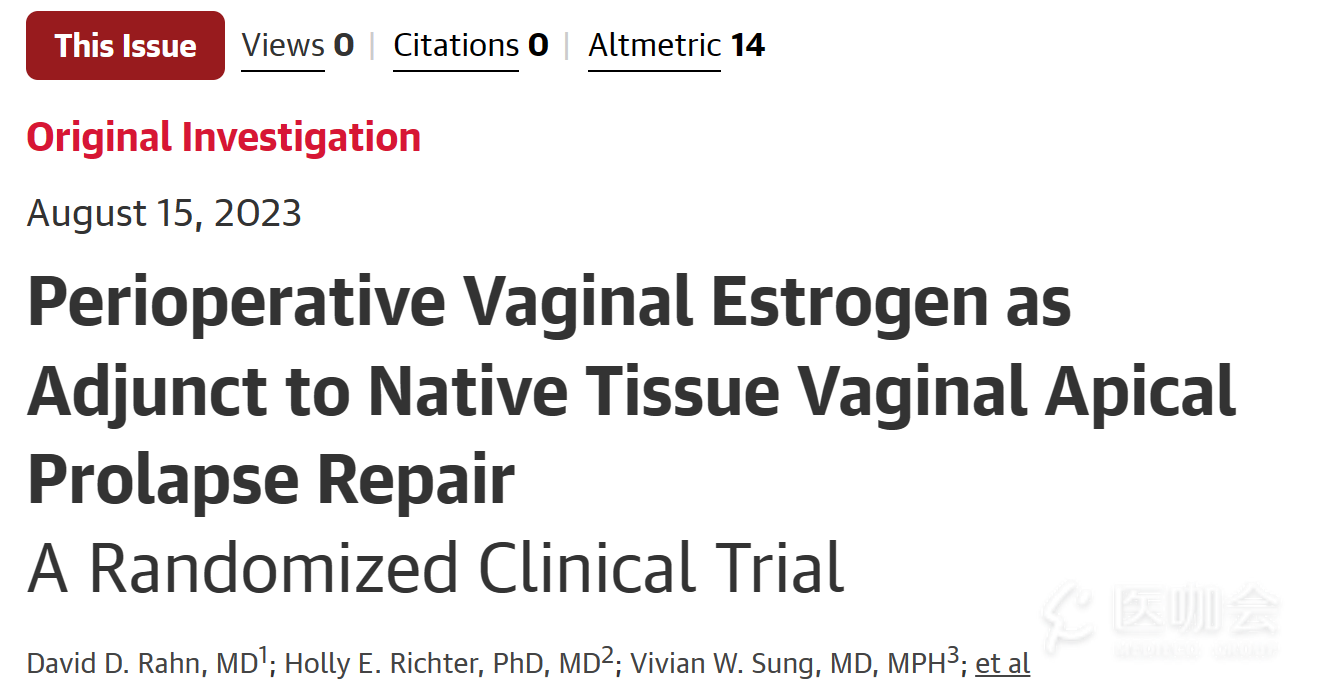JAMA:围术期阴道雌激素作为天然组织阴道顶端脱垂修复的辅助手段:一项随机临床试验
本文由小咖机器人翻译整理
期刊来源:JAMA
文献发表时间:2023-08-15
原文链接:https://jamanetwork.com/journals/jama/article-abstract/2808329
关键点内容如下:
问题
在接受标准化自然组织顶端阴道脱垂修复的绝经后妇女中,围手术期应用阴道内雌激素乳膏是否能减少脱垂复发?
调查结果
这项随机临床试验纳入了186名有症状的阴道前壁/顶端脱垂患者,与安慰剂组相比,手术前后使用阴道雌激素软膏的患者在手术后12个月治疗失败的综合指标无统计学显著差异(调整后的风险比为1.97)。
意义
围术期阴道雌激素应用不能降低自然组织经阴道修补术后脱垂复发率。
摘要内容如下:
重要性
根尖/子宫阴道脱垂的手术修复通常使用天然组织骨盆韧带作为子宫切除术后阴道断端的附着点。临床医生可能会推荐阴道雌激素以减少脱垂复发,但阴道内雌激素对手术治疗脱垂的影响尚不确定。
目的
比较围术期阴道雌激素与安慰剂软膏对自然组织手术脱垂修复后脱垂复发的疗效。
研究设计和参与者
该随机优效性临床试验在3个三级美国临床中心(德克萨斯州、阿拉巴马州、罗德岛州)进行。2016年12月至2020年2月期间,在泌尿妇科诊所登记了206名患有令人烦恼的阴道前壁和顶端脱垂的绝经后妇女,她们对手术修复感兴趣。
干预
干预措施为1 g结合雌激素乳膏(0.625mg/G)或安慰剂,每晚阴道放置2周,然后每周两次,以完成至少5周的术前应用;术后每周两次,持续12个月。参与者接受阴式子宫切除术(如果存在子宫)和标准化根尖固定术(子宫骶骨或骶棘韧带固定术)。
主要结果和措施
主要转归是术后12个月脱垂修复失败的时间,由以下3个转归中的至少1个定义:解剖/客观的前壁或后壁脱垂超过处女膜或顶点下降超过阴道长度的三分之一,主观的阴道隆起症状,或反复脱垂治疗。次要转归包括泌尿和性功能指标、泌尿生殖器萎缩的症状和体征以及不良事件。
次要结果
在206名绝经后妇女中,199名被随机分组,186名接受了手术。参与者的平均(SD)年龄为65(6.7)岁。在12个月内,接受阴道雌激素治疗的妇女与接受安慰剂治疗的妇女的主要转归没有显著差异:阴道雌激素治疗的12个月失败率为19%(n=20),安慰剂组为9%(n=10)(调整后的风险比为1.97[95%CI,0.92-4.22]),解剖复发成分是最常见的,而不是阴道隆起症状或脱垂重复治疗。在手术时,蒙面外科医生对阴道组织质量和雌激素作用的评估在阴道雌激素组中明显更好。在基线时至少有中度令人烦恼的阴道萎缩症状的参与者亚组(n=109)中,在使用阴道雌激素12个月时,大多数令人烦恼的症状的阴道萎缩评分明显更好。
结论和相关性
在自然组织经阴道脱垂修复后,围手术期阴道雌激素的辅助应用并不能提高手术成功率。
英文原文如下:
Key Points
Question Does perioperative application of intravaginal estrogen cream in postmenopausal women undergoing a standardized native tissue apical vaginal prolapse repair reduce prolapse recurrence?
Findings In this randomized clinical trial that included 186 participants with symptomatic anterior/apical vaginal prolapse, there was no statistically significant difference in the composite measure of treatment failure 12 months after the operation in those using vaginal estrogen cream before and after surgery compared with placebo (adjusted hazard ratio, 1.97).
Meaning Perioperative vaginal estrogen application does not reduce prolapse recurrence rates after native tissue transvaginal repair.
Abstract
Importance Surgical repairs of apical/uterovaginal prolapse are commonly performed using native tissue pelvic ligaments as the point of attachment for the vaginal cuff after a hysterectomy. Clinicians may recommend vaginal estrogen in an effort to reduce prolapse recurrence, but the effects of intravaginal estrogen on surgical prolapse management are uncertain.
Objective To compare the efficacy of perioperative vaginal estrogen vs placebo cream on prolapse recurrence following native tissue surgical prolapse repair.
Design, Setting, and Participants This randomized superiority clinical trial was conducted at 3 tertiary US clinical sites (Texas, Alabama, Rhode Island). Postmenopausal women (N = 206) with bothersome anterior and apical vaginal prolapse interested in surgical repair were enrolled in urogynecology clinics between December 2016 and February 2020.
Interventions The intervention was 1 g of conjugated estrogen cream (0.625 mg/g) or placebo, inserted vaginally nightly for 2 weeks and then twice weekly to complete at least 5 weeks of application preoperatively; this continued twice weekly for 12 months postoperatively. Participants underwent a vaginal hysterectomy (if uterus present) and standardized apical fixation (either uterosacral or sacrospinous ligament fixation).
Main Outcomes and Measures The primary outcome was time to failure of prolapse repair by 12 months after surgery defined by at least 1 of the following 3 outcomes: anatomical/objective prolapse of the anterior or posterior walls beyond the hymen or the apex descending more than one-third of the vaginal length, subjective vaginal bulge symptoms, or repeated prolapse treatment. Secondary outcomes included measures of urinary and sexual function, symptoms and signs of urogenital atrophy, and adverse events.
Results Of 206 postmenopausal women, 199 were randomized and 186 underwent surgery. The mean (SD) age of participants was 65 (6.7) years. The primary outcome was not significantly different for women receiving vaginal estrogen vs placebo through 12 months: 12-month failure incidence of 19% (n = 20) for vaginal estrogen vs 9% (n = 10) for placebo (adjusted hazard ratio, 1.97 [95% CI, 0.92-4.22]), with the anatomic recurrence component being most common, rather than vaginal bulge symptoms or prolapse repeated treatment. Masked surgeon assessment of vaginal tissue quality and estrogenization was significantly better in the vaginal estrogen group at the time of the operation. In the subset of participants with at least moderately bothersome vaginal atrophy symptoms at baseline (n = 109), the vaginal atrophy score for most bothersome symptom was significantly better at 12 months with vaginal estrogen.
Conclusions and Relevance Adjunctive perioperative vaginal estrogen application did not improve surgical success rates after native tissue transvaginal prolapse repair.





